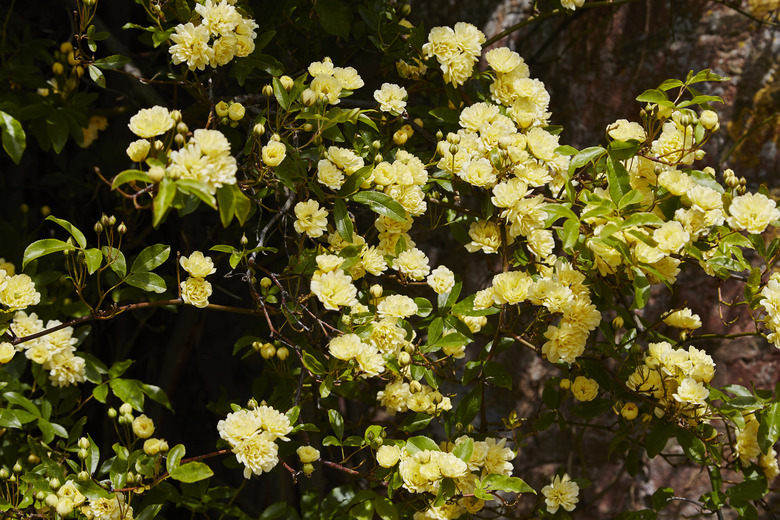How To Care For A Lady Banks Rose
Scrambling up arbors, spilling over pergolas, or espaliered against garden walls, a Lady Banks rose (Rosa banksiae) is a captivating climbing species rose. This plant will even sprawl along the ground if there's nothing to support vertical growth.
Across its perennial range in U.S. Department of Agriculture plant hardiness zones 6 through 11, Lady Banks may be evergreen or deciduous depending on the location. Generally speaking, it's deciduous in zones 6 through 8 (the cooler regions of its perennial range) and evergreen in the warmer climates of zones 9 through 11.
In springtime, Lady Banks is covered with single or double flowers, which may be single white (Rosa banksiae normalis), double white (R. banksiae banksiae), single yellow (R. banksiae lutescens) or double yellow (R. banksiae lutea). The individual flowers are only about 1 inch in diameter, but their visual impact is magnified because they are borne in clusters. Lady Banks is a remarkably low-maintenance plant that needs only minimal care to perform beautifully year after year.
Lady Banks Rose Sun, Water, and Soil Needs
|
Sun |
Partial shade to full sun |
|
Water |
1 inch per week, but drought-tolerant when established |
|
Soil |
Needs good drainage |
Although the Lady Banks rose flourishes in full sun, it also tolerates a partial-shade location. Flowering is reduced, however, where there's too much shade. The springtime floral show won't be nearly as dramatic in a shady spot. It's not too fussy about the type of soil as long as there's good drainage.
Water Lady Banks as you would any other type of rose, making sure it receives 1 inch of water per week. After your plant is established, it's tolerant of drought. You'll only have to water mature plants during times of intense heat or lengthy droughts. Conserve soil moisture by applying a 2- to 3-inch layer of mulch around your plant, pulling it back so that it doesn't keep the canes moist at ground level.
If a soil test indicates the need for fertilizer, follow all recommendations from the test results for the rate and type of fertilizer needed. In the absence of a soil test, fertilize Lady Banks with a water-soluble rose fertilizer, making periodic applications throughout the growing season and following all label directions.
If you're using a slow-release rose fertilizer, you may only have to make one application at the beginning of the growing season. If you're using an organic rose fertilizer, you may need to make monthly applications during the growing season so that your Lady Banks plant receives the nutrients it needs to bloom to its potential the following spring.
Pruning Needs and Potential Problems
With canes that can reach 50 feet in length, a Lady Banks rose absolutely requires pruning unless your garden includes a perfect spot for it to run rampant. Because this rose blooms only once a year in spring, timing your pruning is essential to make sure you don't remove developing flower buds. Wait until after it's finished flowering in spring to prune its long canes. Avoid pruning after July. Sterilize your pruners by wiping the blades with 70 to 100 percent alcohol before each cut.
Unlike many types of roses, Lady Banks doesn't suffer from any of the diseases that typically plague many roses. It may succumb to fungal root rot if the roots remain in waterlogged soil for extended periods, which is why well-draining soil is important to this plant's healthy growth.
